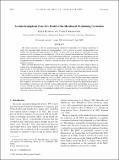An Interhemispheric Four-Box Model of the Meridional Overturning Circulation
Author(s)
Stone, Peter H.; Krasovskiy, Yuriy P.
DownloadStone-2011-Mar-An Interhemispheric Four-Box.pdf (1.115Mb)
PUBLISHER_POLICY
Publisher Policy
Article is made available in accordance with the publisher's policy and may be subject to US copyright law. Please refer to the publisher's site for terms of use.
Terms of use
Metadata
Show full item recordAbstract
The authors introduce a four-box interhemispheric model of the meridional overturning circulation. A single box represents high latitudes in each hemisphere, and in contrast to earlier interhemispheric box models, low latitudes are represented by two boxes—a surface box and a deep box—separated by a thermocline in which a balance is assumed between vertical advection and vertical diffusion. The behavior of the system is analyzed with two different closure assumptions for how the low-latitude upwelling depends on the density contrast between the surface and deep low-latitude boxes. The first is based on the conventional assumption that the diffusivity is a constant, and the second on the assumption that the energy input to the mixing is constant.
There are three different stable equilibrium states that are closely analogous to the three found by Bryan in a single-basin interhemispheric ocean general circulation model. One is quasi-symmetric with downwelling in high latitudes of both hemispheres, and two are asymmetric solutions, with downwelling confined to high latitudes in one or the other of the two hemispheres. The quasi-symmetric solution becomes linearly unstable for strong global hydrological forcing, while the two asymmetric solutions do not.
The qualitative nature of the solutions is generally similar for both the closure assumptions, in contrast to the solutions in hemispheric models. In particular, all the stable states can be destabilized by finite amplitude perturbations in the salinity or the hydrological forcing, and transitions are possible between any two states. For example, if the system is in an asymmetric state, and the moisture flux into the high-latitude region of downwelling is slowly increased, for both closure assumptions the high-latitude downwelling decreases until a critical forcing is reached where the system switches to the asymmetric state with downwelling in the opposite hemisphere. By contrast, in hemispheric models with the energy constraint, the downwelling increases and there is no loss of stability.
Date issued
2009-04Department
Massachusetts Institute of Technology. Center for Global Change Science; Massachusetts Institute of Technology. Department of Earth, Atmospheric, and Planetary SciencesJournal
Journal of Physical Oceanography
Publisher
American Meteorological Society
Citation
Stone, Peter H., and Yuriy P. Krasovskiy. “An Interhemispheric Four-Box Model of the Meridional Overturning Circulation.” Journal of Physical Oceanography 41 (2011): 516-530. Web. 19 Oct. 2011. © 2011 American Meteorological Society
Version: Final published version
ISSN
0022-3670
1520-0485